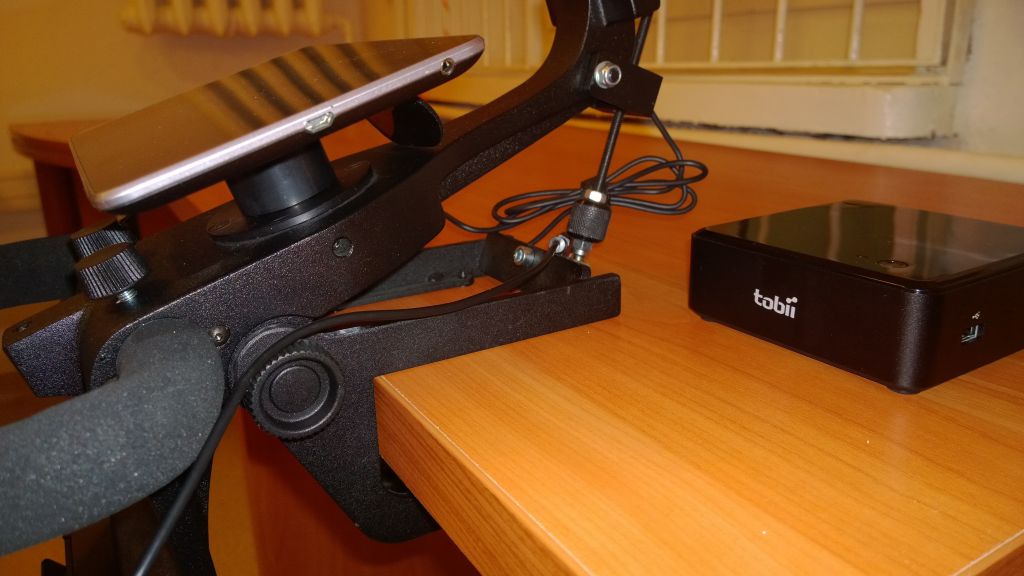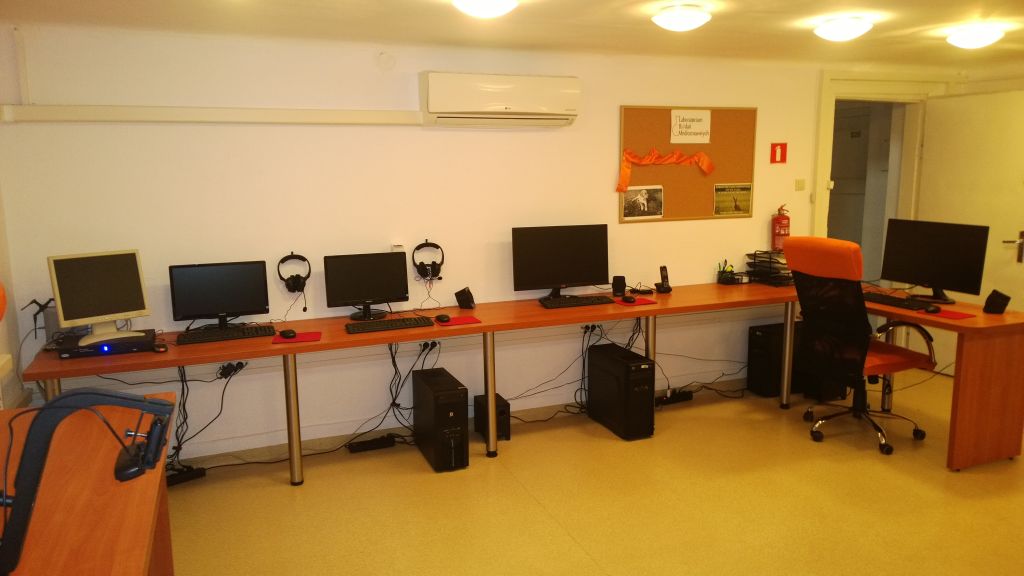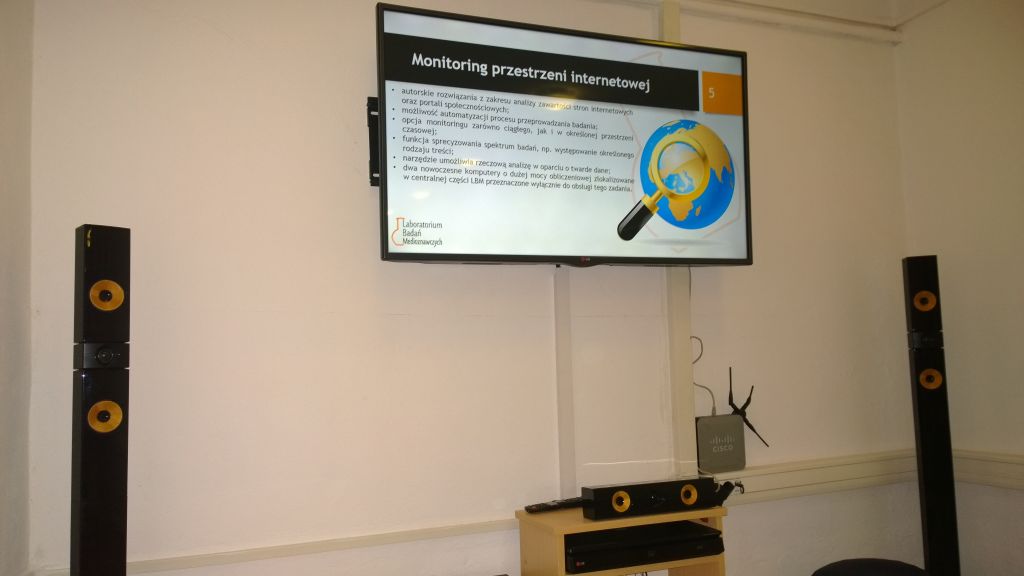Technical capabilities
Technology and equipment provide about the functionality of Laboratory of Media Studies: 2x8-core server processors, ultra-fast internet access, several radio and television channels real time recorder, specialised software, but above all the most modern eyetracker - device to test eyeballs movements.
 I. Server – HP DL380p gen8
I. Server – HP DL380p gen8
- 2x8-core server processors Intel Xeon;
- 96 GB RAM;
- 13,2 TB internal storage;
- two power supplies;
- UPS;
- server hosts internet portals;
- access to multimedia resources and research materials for scientists;
- surveys platform;
- big database able to store : 10k hours of record videocontent, 350k text publications, 32k hours of audiocontent, 116k FullHD photos.
 II. Eye Tracker and Mobile Device
II. Eye Tracker and Mobile Device
- Eye Tracker X2 TOBII 60 – the most modern eye tracker, TOBII Studio 3.4.3 software and superfast ASUS laptop;
- Mobile Device – special arm to mobile device applications usability test;
- the newest solution to test eyeballs movements during use of media - text, tv advertaisment, movie, poster, website, application and more;
- allow to carry out research, eg. types of medium usage quality, in effect reccomend their optimalized - usabiliy tests;
- comprehensive usability tests of mobile phones and tablets;
- small size of the equipment allows to use if outside the laboratory, eg. in a more natural environment for the test.

III. Web crawling
- proprietary solution in the field of content analysis of websites and social media;
- the ability to automate process research;
- precis types of content identifacation;
- two web crawling powerful computers;
- full automatic of data aggregation;
- semi-automatic coding;
- extensive analysis;
- virtual ethnography - cultural network - web 2.0 and 3.0).
 IV.TV and radio monitoring
IV.TV and radio monitoring
- several radio and television channels real time recorder – supported by Stirlitz Media Software;
- the number of channels can be extended with the technological and personal development of Laboratory of Media Studies;
- database allows to make dedicated archives containing materials with specific events and carrying them for further analysis;
- access to materials for research purposes from both - presence in the laboratory and remotely
- easily build a remote research groups, eg. research gruop work from home;
- thematic, problem, incidental and continuous monitoring;
- quality coding in research teams and semi-automatic language recoding - quantitative transcription, automatic and semi-automatic transcription;
- automatic image recognition - in process.
 V. CATI, CAWI, CASI
V. CATI, CAWI, CASI
- CATI studio - able to use as part of CASI - computer assisted self interviews;
- 15 complete computer desks;
- low energy and mini computers - one desktop takes only less than 42W power;
- very quiet work of computer to make telephone surveys more effective;
- all computers run on Microsoft Windows 10;
- random digital-dialing software to computer assisted telephone interviews;
- CATI studio can be used to experimental tests requiring computer support;

VI. FGI studio
- 50" interactive, the newest TV with Blue-ray player and HD camera make possible to perform multimedial shows in 2D and 3D technologies.
- specially arranged studio (equipped with Venetian glass and several colorful poof) create an intimate, unique atmosphere for respondents;
- possibility of carrty out ProfFGI (with experts, specialists);
- studio can be used as a training room;
- studio enable to make pre-release screening of a film analysis with record of brainstorm after show.

VII. Projection room
- 50" interactive, the newest TV with Blue-ray player and HD camera make possible to perform multimedial shows in 2D and 3D technologies;
- home theater system;
- hybrid TV technology cooperating with wiraless solutions and streaming systems;
- room enable to do advertisment tests - also using Eye Tracker X2 TOBII 60;
- tests videocontent published on eg. YouTube, Vimeo
- tests SD vs. HD and 3D;
- visual preparing to FGI;
- possibility of carry out advanced training and expert workshops.
 VIII. Techologies - full compatiblity
VIII. Techologies - full compatiblity
- Laboratory of Media Studies is full of advanced technologies, which are compabile with each other;
- the most important in compatibility is super fast cable and wiraless internet access;
- all the computers work on the basis of processors Intel Haswell and Ivy Bridge;
- easy share functions by using wiraless technologies eg. DLNA, Intel WiDi, Bluetooth;
- TV and monitor displays on the basis of LED technology - very good quality and low energy consumption;
- Laboratory of Media Studies is possible to design and perform a specific research project (due to the given problem), but also to organize and carry out the process of implementing changes and recommendations.
 IX. The newest software
IX. The newest software
- LBM has programs useful during research activities and further processing and publication;
- Adobe CS6 - set of different Adobe application for designing, animation and other multimedia activities;
- Camtasia Studio 8's TechSmith - advanced software to create video instruction and training materials;
- Microsoft Office 2013 allow to make all office operations, further enhanced by group work together on common documents and storage resources in the "cloud";
- if it is possible Laboratory of Media Studies use open-source software, cuurently has:
- – Debian Linux Server on the main server of Laboratory of Media Studies;
- – Office suite LibreOffice as a complement to Microsoft Office 2013 in the range of accurate and full service open formats of electronic documents.
 X. Books and newspapers monitoring
X. Books and newspapers monitoring
- Polish researchers could instantly browse newspapers and books from the period in terms of their interest phrases, contexts, statements, descriptions. Ultimately Laborratory of Media Studies also would create a library of the most important positions, including foreign languages.
XI. Databeses
About us
 {nomultithumb}Laboratory of Media Studies (Laboratorium Badań Medioznawczych UW – referred here as LBM UW) created and operating thanks to intentional subsidiary of Ministry of Science and Higher Education (decision no 8617/E-343/R/2013 of 12 June 2013) is today the only national research institution disposing of high-tech equipment for advanced media studies researches of media messages (in triangulation conceptualization using both traditional (declarative) methods and nonreactive methods with a special use of behavioral methods such as eye-tracking tests). By all means, in Poland there are advanced research institutes subsidiary of high-tech research equipment for example concerning visual culture. Research laboratory dealing mainly with psychological researches of Prof. PhD with habilitation Piotr Francuz of Catholic University of Lublin who is subsidiary of great equipment for behavioral research (for example eye-trackers of high frequencies, stationary and mobile as well as fMRI and EEG for testing brain waves influenced by specific incentives). However, as the Media Studies Research Laboratory (LBM), we would like to focus on different aspects in our empirical researches on visual culture. We would like to test typical media broadcasts – popular films, television series, talk-shows, and talent-shows as well as cartoons, news programs, and journalistic programs broadcasted in Polish television channels paying special attention to their emotional engagement potential and recipients’ – viewers’ – focus on the message. Described below original integrated system of monitoring and analyzing audiovisual media messages supported by biometric analysis of the receiver by eye-tracking and facial expression (Facial EMG) allows conducting all types of research of empirical studies on visual culture with the use of static (photographs, collages, memes, cartoons etc.) and dynamic image (all types of moving audiovisual materials).
{nomultithumb}Laboratory of Media Studies (Laboratorium Badań Medioznawczych UW – referred here as LBM UW) created and operating thanks to intentional subsidiary of Ministry of Science and Higher Education (decision no 8617/E-343/R/2013 of 12 June 2013) is today the only national research institution disposing of high-tech equipment for advanced media studies researches of media messages (in triangulation conceptualization using both traditional (declarative) methods and nonreactive methods with a special use of behavioral methods such as eye-tracking tests). By all means, in Poland there are advanced research institutes subsidiary of high-tech research equipment for example concerning visual culture. Research laboratory dealing mainly with psychological researches of Prof. PhD with habilitation Piotr Francuz of Catholic University of Lublin who is subsidiary of great equipment for behavioral research (for example eye-trackers of high frequencies, stationary and mobile as well as fMRI and EEG for testing brain waves influenced by specific incentives). However, as the Media Studies Research Laboratory (LBM), we would like to focus on different aspects in our empirical researches on visual culture. We would like to test typical media broadcasts – popular films, television series, talk-shows, and talent-shows as well as cartoons, news programs, and journalistic programs broadcasted in Polish television channels paying special attention to their emotional engagement potential and recipients’ – viewers’ – focus on the message. Described below original integrated system of monitoring and analyzing audiovisual media messages supported by biometric analysis of the receiver by eye-tracking and facial expression (Facial EMG) allows conducting all types of research of empirical studies on visual culture with the use of static (photographs, collages, memes, cartoons etc.) and dynamic image (all types of moving audiovisual materials).


